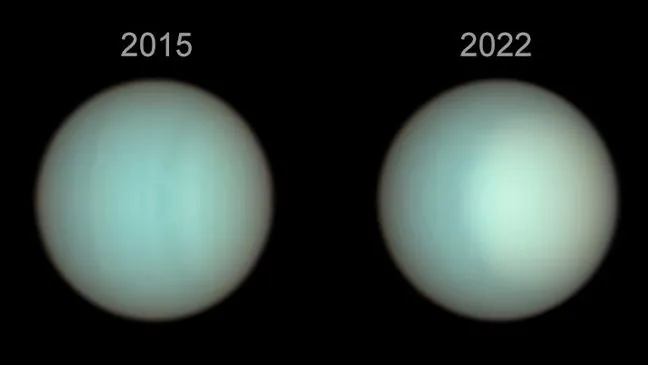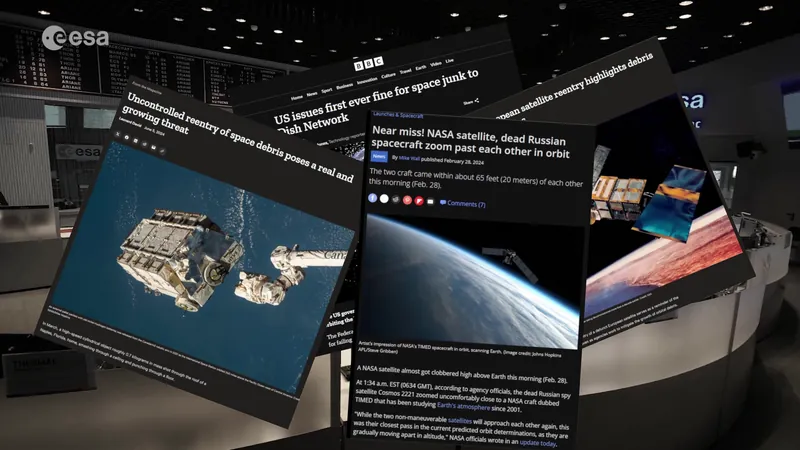
Hubble Space Telescope Sheds Light on Uranus' Seasonal Mysteries Over Two Decades
2025-04-01
Author: Arjun
Introduction
For the first time in twenty years, a meticulous analysis of data captured by NASA's Hubble Space Telescope has unveiled intriguing changes in Uranus's atmosphere, intricately influenced by solar radiation. The seventh planet from the sun is renowned for its strikingly unique axial tilt, which positions its equator almost at a right angle to its orbit. This unusual alignment, believed to be the result of a violent collision with an Earth-sized object in the distant past, generates extreme seasonal differences—resulting in prolonged, dark winters and bright, sun-soaked summers for its poles.
Understanding Uranus
Despite these captivating characteristics, Uranus remains one of the most enigmatic planets in our solar system. Its only interaction with a spacecraft occurred nearly 40 years ago when Voyager 2 flew by, coinciding with an exceptional solar event that obscured our understanding of this distant ice giant.
The Research
In an ambitious effort to unlock the secrets of this remote world, astronomer Erich Karkoschka from the University of Arizona and his team embarked on an extensive study utilizing Hubble's Space Telescope Imaging Spectrograph to monitor seasonal changes in Uranus over the span of two decades. Given that Uranus takes over 84 Earth years to complete a single orbit around the sun, the team focused their observations primarily on the progression of the northern spring, anticipated to peak as the sun transitions from illuminating the equator to shining directly over the north pole by 2030.
Findings
The team's findings revealed stark contrasts in the planet's atmospheric conditions as illustrated by Hubble's series of images. These images depict the southern polar region darkening as it succumbs to winter's grasp, while simultaneously, the north pole experiences increasing brightness as it approaches summer.
Uranus’ Atmosphere
Uranus’s atmosphere, primarily composed of hydrogen and helium, is tinged with methane, which filters out red light and gives the planet its signature blue-green glow. The analysis conducted from 2002 to 2022 included four pivotal observations (in 2002, 2012, 2015, and 2022), enriching our understanding of Uranus's atmospheric structure far beyond the data gathered from the Voyager 2 flyby. The results suggest intricate atmospheric circulation patterns, with methane exhibiting both upwelling in some areas and downwelling near the poles.
Further Discoveries
Interestingly, the researchers discovered an uneven distribution of methane; depletion occurs around the poles, a pattern that has remained consistent through the years. Additionally, they observed significant changes in aerosol concentrations, which are crucial for mapping the planet's atmospheric architecture. While the mid and low latitudes exhibited relative stability in methane levels and aerosol patterns over two decades, the poles showed marked changes, particularly with brightening aerosols near the north pole as summer approached.
Conclusion
These revelations not only deepen our understanding of Uranus's atmospheric dynamics but also potentially offer a template for studying exoplanets of similar size and composition. The implications of this research extend far beyond our solar system, opening new avenues for exploring the atmospheres of distant worlds.
As scientists continue to gather data from Hubble, they invite space enthusiasts to join the journey, eager to uncover more secrets hidden within the icy depths of Uranus. Every observation brings us one step closer to unraveling the mysteries of our celestial neighbors!




 Brasil (PT)
Brasil (PT)
 Canada (EN)
Canada (EN)
 Chile (ES)
Chile (ES)
 Česko (CS)
Česko (CS)
 대한민국 (KO)
대한민국 (KO)
 España (ES)
España (ES)
 France (FR)
France (FR)
 Hong Kong (EN)
Hong Kong (EN)
 Italia (IT)
Italia (IT)
 日本 (JA)
日本 (JA)
 Magyarország (HU)
Magyarország (HU)
 Norge (NO)
Norge (NO)
 Polska (PL)
Polska (PL)
 Schweiz (DE)
Schweiz (DE)
 Singapore (EN)
Singapore (EN)
 Sverige (SV)
Sverige (SV)
 Suomi (FI)
Suomi (FI)
 Türkiye (TR)
Türkiye (TR)
 الإمارات العربية المتحدة (AR)
الإمارات العربية المتحدة (AR)